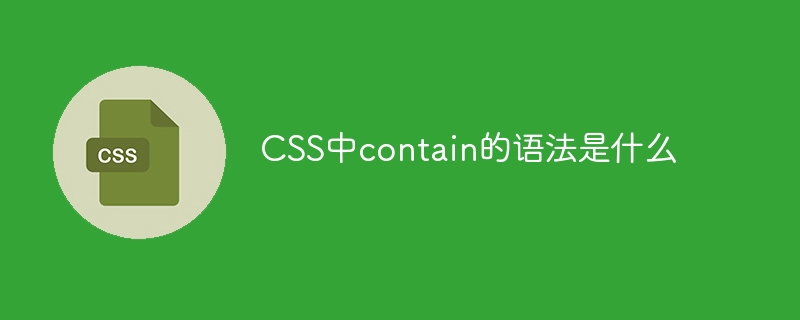Home >Web Front-end >CSS Tutorial >What is the syntax of the contain attribute in CSS?
What is the syntax of the contain attribute in CSS?
- 王林Original
- 2024-02-25 13:51:06807browse

The contain attribute in CSS is used to specify whether an element should contain or be included within other elements. By setting the contain attribute, you can tell the browser which elements should be processed independently, thereby improving the rendering performance of the page. The syntax of the
contain attribute is as follows:
contain: layout [paint] [size] [style]
-
layout: Indicates whether the element should be laid out independently of other elements. Optional values are:
none,strict, andcontent.-
none: Indicates that the element will not affect the layout of other elements, nor will it be affected by other elements. -
strict: Indicates that the element will affect the layout of other elements, but will not be affected by other elements. -
content: Indicates that the element will only be affected by its direct parent element and will not affect other elements.
-
-
paint: Indicates whether the element should be drawn independently of other elements. Optional values are:
noneandcontents.-
none: Indicates that the element itself will not be drawn and will not produce visual effects. -
contents: Indicates that the element will be drawn and will produce visual effects.
-
-
#size: Indicates whether the element should be sized independently of other elements. Optional values are:
none,content, andstrict.-
none: Indicates that the size calculation of the element does not depend on its internal content. -
content: Indicates that the size calculation of the element depends on the size of its internal content. -
strict: Indicates that the size calculation of an element only depends on the size of its direct child elements and has nothing to do with the internal content.
-
-
#style: Indicates whether the element should have its style calculated independently of other elements. Optional values are:
noneandcontents.-
none: Indicates that the element's style calculation does not depend on its internal content and child elements. -
contents: Indicates that the element's style calculation depends on its internal content and child elements.
-
The following are some specific code examples:
/* 设置元素在布局上独立于其他元素 */
.container {
contain: layout;
}
/* 设置元素在绘制上独立于其他元素 */
.box {
contain: paint;
}
/* 设置元素在尺寸计算上独立于其他元素 */
.img-container {
contain: size;
}
/* 设置元素在样式计算上独立于其他元素 */
.card {
contain: style;
}In the above example, the .container class sets the element to be independent of other elements The layout of the .box class sets the drawing of elements independent of other elements, the .img-container class sets the size calculation of elements independent of other elements, .cardClass sets the style calculation of an element independently of other elements.
By using the contain attribute, we can optimize page rendering performance, reduce unnecessary reflow and redraw operations, and improve user experience.
The above is the detailed content of What is the syntax of the contain attribute in CSS?. For more information, please follow other related articles on the PHP Chinese website!
Related articles
See more- What is reflow and redraw
- What is the use of reflow and redraw?
- Understand the difference between reflow and repaint: the key to optimizing web page performance
- Understanding redraw and reflow: which rendering stage is more affected?
- Optimizing for optimal performance: Redraw and reflow avoidance strategies front-end developers must know

